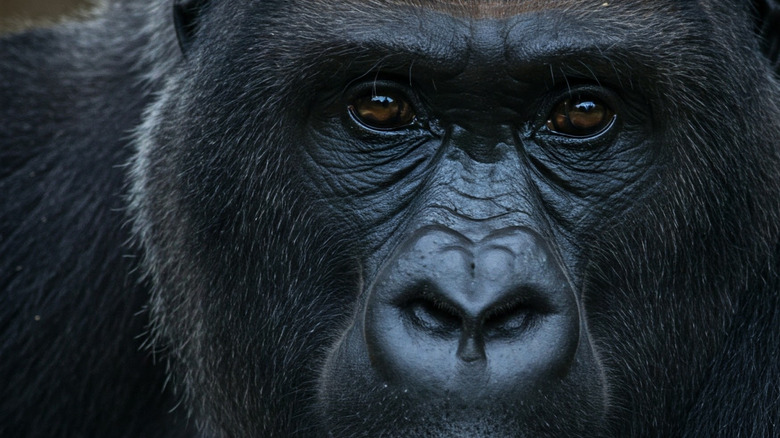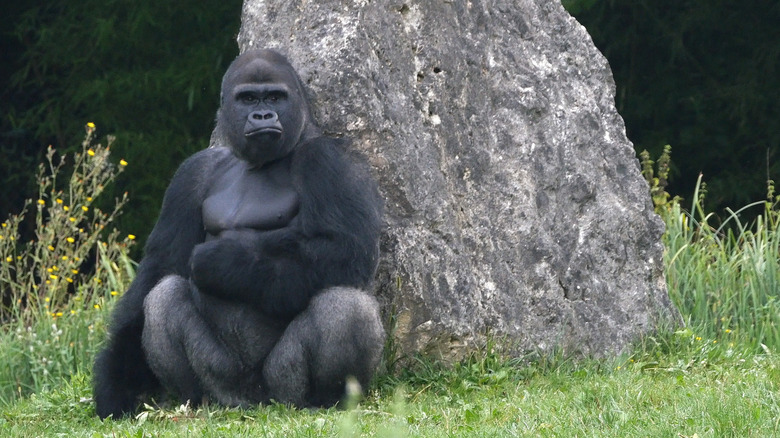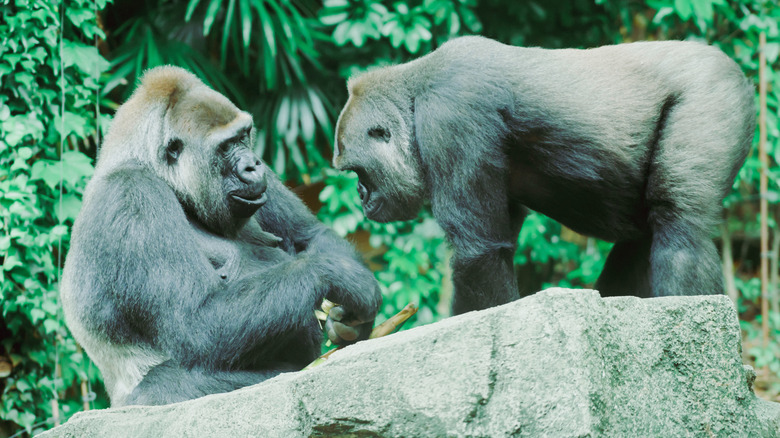The Largest Gorillas Ever Were From This Huge Subspecies
The largest gorillas ever recorded weren't exactly King Kong in size, but they certainly weren't creatures you'd ever want to tangle with. The tallest verified wild gorilla was a six-foot, four-and-three-quarter-inch tall male killed by hunters in 1938 near Alimbongo in what is now the Democratic Republic of the Congo. It wasn't the heaviest wild gorilla on record though, as that title goes to a 482-pound male also killed in the same region, around Lake Kivu, in 1929. In addition to these specimens, there are a number of anecdotal tales of hunters killing even larger gorillas, sometimes as heavy as 588 pounds, but these are only estimates.
In captivity, gorillas grow even larger, with the heaviest verified individual being a male resident of the San Diego Zoo named N'gagi, who weighed in at 636 pounds at the time of his death in 1944. N'gagi had something in common with the two record-holding wild gorillas. They were all eastern gorillas.
Gorillas are divided into two species: western gorillas (Gorilla gorilla) and eastern gorillas (G. beringei). Each species has two subspecies, with the eastern gorillas divided into Grauer's gorillas (G. b. grauri) and mountain gorillas (G. b. beringei). Unfortunately, these classifications weren't made until 2001, long after the record-holding gorillas were gone. Some believed them to be mountain gorillas, but they were more likely Grauer's gorillas, also known as eastern lowland gorillas, which we now know to be not just the largest gorillas, but the largest of all living primates species.
The incredible bodies of eastern lowland gorillas
Eastern lowland gorillas are found, as their name would indicate, in the eastern part of the Democratic Republic of the Congo. Fully grown silverback gorillas of this subspecies typically stand between five and six feet tall, and weigh 220–460 pounds. For comparison, the average adult human male in the United States stands five feet, nine inches tall and weighs around 200 pounds, per the CDC.
It could be argued that the largest primate ever was a human, that being Jon Brower Minnoch, who holds the record for the heaviest human ever recorded at a maximum weight of 1,400 pounds. However, 80% of that weight was pure body fat, which makes a stark contrast with the biggest gorillas. Gorillas only have about 20% body fat, which is slightly below the average human adult male. They get their incredible weight mainly from muscle, which is why gorillas are incredibly strong animals.
Eastern lowland gorillas, like most primates, show significant sexual dimorphism, with the females reaching a maximum weight of just about 215 pounds. There can also be substantial variance between males, with alpha male status, and the mating priority that accompanies it, typically correlating to size.
The world's biggest gorillas are in serious danger
Being the biggest primate in the world is of little help when facing the threat of the most destructive primates in the world: human beings. Sadly, gorillas are among the many animal species currently on the brink of extinction. With just 2,600 mature individuals believed to exist in the wild, the eastern gorilla is listed as critically endangered on the IUCN Red List. Grauer's gorillas in particular have lost more than 85% of their historical range, and their populations continue to decline.
There are multiple factors behind the aggressive decline in the eastern lowland gorilla population. Habitat destruction has been the primary issue, driven by a combination of logging, mining, and converting historical forest land into farms and livestock ranches. According to the World Resources Institute, the Democratic Republic of the Congo, where eastern lowland gorillas reside, has the third highest deforestation rate of any country. Illegal logging plays a major role in this.
Decades of violence in the DRC have also had a significant hand in the current plight of the eastern lowland gorilla. Since the 1990s, millions of people have been killed in a ceaseless series of wars, and gorillas have also suffered in the process. An influx of firearms and a population increasingly strapped for resources has led to a rise in poaching gorillas for bush meat. Conservationists are desperate to save this subspecies, but as long as warfare persists, even checking in on these animals is a monumental challenge.


